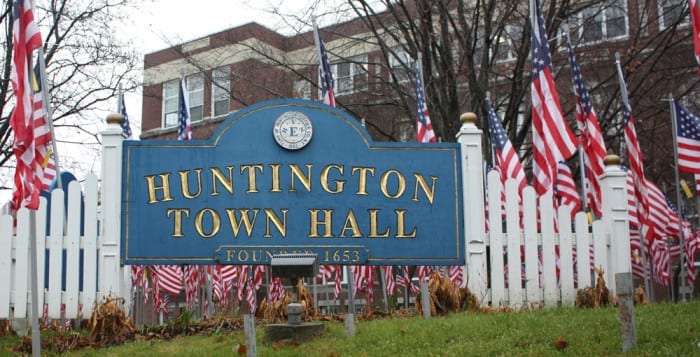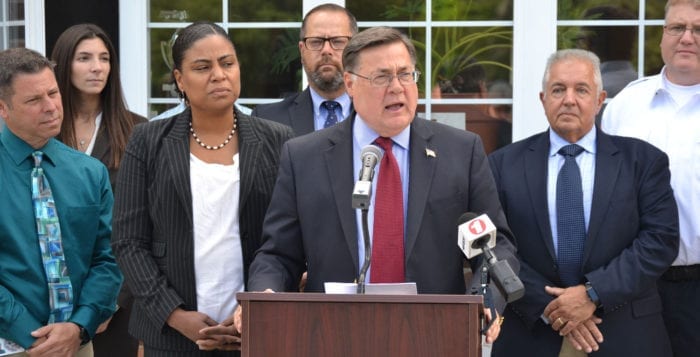Brookhaven Town Supervisor Ed Romaine (R) got into politics to get things done. After two terms as the town’s leader, which came after a lengthy career working for the county, the 70-year-old Center Moriches resident says he still has a job to do.
“What gets me up every single morning is that I want to build a better Brookhaven,” Romaine said. “This town can look a lot better than it does. I have a sense of purpose and it drives me every day. While I don’t think my job will ever be complete, I hope to leave more good than bad whenever I leave this office — and I work every day to accomplish that.”
The incumbent supervisor will run for a third full term in Brookhaven in an election this November against challenger Jack Harrington (D), a Stony Brook attorney and political newcomer.
Romaine, the former high school history teacher-turned-county legislator, grew up in Bayport and Central Islip, graduated with history and political science degrees from Adelphi and Long Island universities. He said he devotes any time outside town hall to his two grandchildren. If re-elected, Romaine said he will build on his long list of initiatives to move Brookhaven forward.
“What gets me up every single morning is that I want to build a better Brookhaven.”
— Ed Romaine
Since taking over the position from former Supervisor Mark Lesko (D) after a special election in 2012, Romaine has helped pull the township out of its fiscal crisis to become the only municipality on Long Island to pay off all of its pension debt. For the last two years, Brookhaven has secured a AAA bond rating, the highest designation issued by Standard & Poor’s Financial Services of New York City.
A lifelong advocate for environmental preservation, Romaine consistently pushes for greener, cleaner living across Brookhaven and has been endorsed by the Sierra Club and Long Island Environmental Voters Forum during past campaigns. He also pledged a commitment to the Paris agreement in the wake of the June decision of President Donald Trump (R) to withdraw from the climate change agreement.
“I intend to defend the environment,” Romaine said. “I’m a big open-space guy. I believe in preservation because I do not want to see the wave of development that has swept east to west across this Island continue.”
Under Romaine’s supervision, the town created nitrogen protection zones to preserve local waterways, kick-started a multiyear project to convert all of Brookhaven’s streetlights to LED bulbs, opposed dumping of dredge spoils into the Long Island Sound and opposed plans to clear 800 acres of woodlands near the former Shoreham power plant.
In July, the town launched a food scrap composting program at town hall to reduce food waste and use the materials for garden beds around town buildings. Also, more than 100 abandoned homes have been demolished across the hamlets, the supervisor said, in an effort to stamp out eyesores and criminal activity in quaint neighborhoods.
“The thing I like most about this job is you can actually make a difference,” Romaine said, adding that successes are made possible because of a mixed-party town board — four Republicans, one Democrat and one Conservative — that he said votes together 99.9 percent of the time.
He made it clear he works with people of all parties and values common ground.
“It’s less about party affiliations and more about common sense and practicality, and doing what works,” Romaine said. “You’re not coming to put boxing gloves on. You’re coming here to do some heavy lifting and that requires teamwork. I am blessed with six good people who vote together, don’t look to create party differences or personality disputes, which you do see in other towns.”
“His breadth of knowledge is incredibly impressive, and I always learn something when I’m with him.”
— Jane Bonner
High among his Democratic allies is state Assemblyman Steve Englebright (D-Setauket), who was elected into public office on the same day as Romaine nearly 40 years ago. The two have since worked together on countless issues, oftentimes pertaining to preserving the waterways and natural environment of Brookhaven Town and Long Island as a whole.
During a recent interview, Englebright called Romaine “a peacemaker” who can draw people to their commonalities and pays attention to the things that bring people together.
The assemblyman also credited Romaine with serving as a conduit to Republican state Sens. John Flanagan and Ken LaValle, who have taken up the mantle of inviting local leaders from both parties “into the photo,” so to speak.
Councilwoman Jane Bonner (C-Rocky Point) said all levels of government could learn a lesson from how Romaine leads Brookhaven.
“He eats and sleeps this job,” Bonner said, adding how effective she believes Romaine is. “A board that works as well as we do together benefits the taxpayer. His breadth of knowledge is incredibly impressive, and I always learn something when I’m with him.”
But for all its strength, Romaine said he’s not blind to Brookhaven’s shortcomings and, on a daily basis, asks himself, “What can we do to make this town better?”
He said he wants to dissolve many special districts in the town in order to cut costs and streamline services, push for better treatment and vocational training facilities for struggling drug addicts, and build better public transportation systems.
At the start of Romaine’s career, he taught history in the Hauppauge school district for 10 years and a parochial school in Cedarhurst for two, all the while writing grants for the school district. In 1980, he entered public service and became Brookhaven’s first commissioner of housing and community development before being appointed director of economic development.
Romaine was elected to the Suffolk County Legislature for two terms, in 1985 and 1987, and became Suffolk County clerk in 1989, a post he served for 16 years.
On the side, he took a job at Dowling College teaching managerial economics for seven years, then moved over to teaching history courses at Suffolk County Community College for another seven before landing at Stony Brook University teaching administrative law at the graduate level in 2005 — the same year he was elected again as county legislator of the 1st Legislative District.
“He will, arguably, go down as one of the most effective, approachable and innovative supervisors in the history of this great town.”
— Jesse Garcia
When he was eventually approached by Jesse Garcia, chairman of the Brookhaven Town Republican Committee, to throw his hat into the ring for supervisor, Romaine hesitated. He said he loved his job as legislator too much.
“I didn’t want to do it,” Romaine recalled. But it was the memory of his late son, former Brookhaven Councilman Keith Romaine, who died in 2009 from pneumonia-related conditions at age 36, that finally convinced him to pursue the position. “I knew if he had lived, he would have been supervisor. Unfortunately, while it’s usually sons that follow fathers, I did it in reverse.”
He said such personal lows in his life have helped inform how he approaches the position.
“The bottom line is, it’s a very short life,” he said. “I didn’t get into politics to call people names. I got into politics to get something done. This job has a lot of frustrations and I’ll be happy when I leave it, but I’m doing my time here because I still have a sense of purpose.”
Garcia said he’s glad Romaine accepted the job when he did.
“What separates Ed Romaine from the rest is just his ability to not look at challenges but look at solutions that benefit the people of this town,” Garcia said, commending the supervisor on his record of tax control, job growth and bipartisanship. “He will, arguably, go down as one of the most effective, approachable and innovative supervisors in the history of this great town.”




























